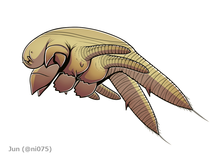Cambropycnogon
| Cambropycnogon Temporal range: Cambrian,
| |
|---|---|

| |
| Reconstruction | |
| Scientific classification | |
| Domain: | Eukaryota |
| Kingdom: | Animalia |
| Phylum: | Arthropoda |
| Subphylum: | Chelicerata |
| Class: | Pycnogonida |
| Genus: | †Cambropycnogon Waloszek and Dunlop, 2002 |
| Species: | †C. klausmuelleri
|
| Binomial name | |
| †Cambropycnogon klausmuelleri Waloszek and Dunlop, 2002
| |
Cambropycnogon klausmuelleri is a presumed
Description
Cambropycnogon is an early-stage pycnogonid larva (although this classification has been disputed[2]) around 270 micrometers long, with three pairs of post-cheliceral appendages as well as the chelicerae that mark it as a possible pycnogonid. It also has two large caudal growths from its posterior end, the purpose of which is unknown. Cambropycnogon is covered in small spines roughly 1 micrometer long, as well as larger thorns behind its gnathobases. Its chelicerae are short and stout, resembling pincers, and the larva has a relatively large head shield. Cambropycnogon's morphology matches that of early sea spider larvae such as the protonymph and semaphoront, with it being markedly distinct from all other Orsten fossils.[1]
Etymology
Cambropycnogon derives from its assumed position within Pycnogonida, as well as the fact that it dates from the Cambrian. Its specific name, klausmuelleri honours the discoverer of the Orsten, Dr Klaus Müller.[1]
Distribution
Cambropycnogon is known from six specimens, all found in Kinnekulle.[1]
References
- ^ .
- PMID 32915961.
